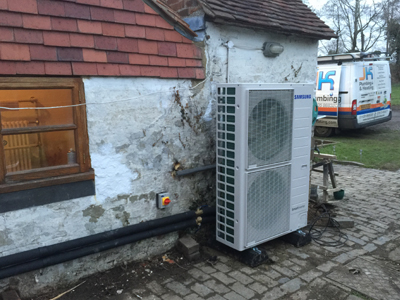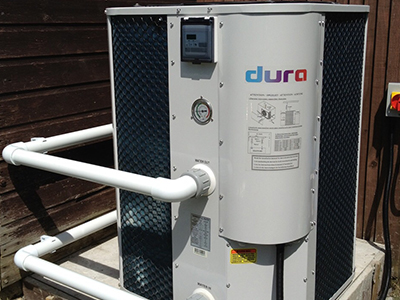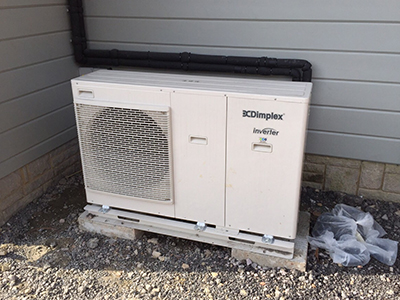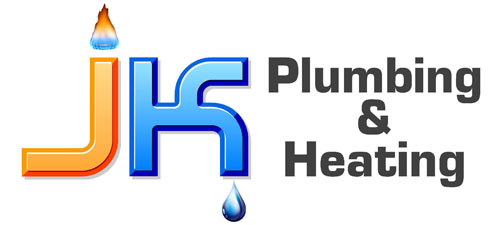
Alternatively, an Air Source Heat Pump (ASHP) looks like an air conditioning unit and typically goes behind or at the side of a property. It takes heat from the air and raises its temperature via a heat pump.
An ASHP works almost like a refrigerator in reverse. The system incorporates an evaporator, a compressor and a condenser. It absorbs heat from the outside air and the heat pump compressor increases its temperature to create ‘useful’ heat both to keep homes toasty and for hot water.
In the summer, an air-to-air heat pump works in reverse, as an air-conditioning unit, so your home stays nice and cool.
There are two key types of ASHP:
- Air-to-water systems which take heat from the outside air and feed it into your wet central heating system. The heat produced is not as warm as a conventional boiler’s, so consider fitting bigger radiators or underfloor heating.
- Air-to-air systems take heat from the air outside and feed it into your home through fans. This type of system doesn’t heat water.
Air source heat pumps features and benefits
- ASHPs work best with underfloor heating systems or with big radiators – the heat the pump generates is lower than that created by a standard radiator, so you need a bigger surface area.
- Air-to-water heat pumps also tend to be well suited to new-build homes – where the heat pump can be included in the building spec, rather than later on.
- Once in place, the heat pump is very low-maintenance.
- There is less disruption than when installing ground source heat pumps, since no digging is needed in your garden.
- If you are replacing electric heating rather than natural gas, ASHPs can generate less carbon than conventional heating systems.

Alternatively, an Air Source Heat Pump (ASHP) looks like an air conditioning unit and typically goes behind or at the side of a property. It takes heat from the air and raises its temperature via a heat pump.
An ASHP works almost like a refrigerator in reverse. The system incorporates an evaporator, a compressor and a condenser. It absorbs heat from the outside air and the heat pump compressor increases its temperature to create ‘useful’ heat both to keep homes toasty and for hot water.
In the summer, an air-to-air heat pump works in reverse, as an air-conditioning unit, so your home stays nice and cool.
There are two key types of ASHP:
- Air-to-water systems which take heat from the outside air and feed it into your wet central heating system. The heat produced is not as warm as a conventional boiler’s, so consider fitting bigger radiators or underfloor heating.
- Air-to-air systems take heat from the air outside and feed it into your home through fans. This type of system doesn’t heat water.
Air source heat pumps features and benefits
- ASHPs work best with underfloor heating systems or with big radiators – the heat the pump generates is lower than that created by a standard radiator, so you need a bigger surface area.
- Air-to-water heat pumps also tend to be well suited to new-build homes – where the heat pump can be included in the building spec, rather than later on.
- Once in place, the heat pump is very low-maintenance.
- There is less disruption than when installing ground source heat pumps, since no digging is needed in your garden.
- If you are replacing electric heating rather than natural gas, ASHPs can generate less carbon than conventional heating systems.

Saving you money on heating
ASHPs are cheaper to install than ground source heat pumps. The Energy Saving Trust (EST) estimates that installing an ASHP system costs typically costs between £7,000 and £11,000.
It reckons that an averagely performing air source heat pump in a standard four-bedroom detached home could save:
- £360 to £555 a year if replacing oil (non-condensing)
- £1,200 and £1,805 a year if replacing LPG (non-condensing)
- £715 and £1,295 a year if replacing electric heating (old storage heaters).
Many air source heat pumps are eligible for payment through the Renewable Heat Incentive.
This could yield an additional £905 to £1,365 annually, according to the EST.
How long it takes to recoup the expense of the system in energy savings, and the reduction in carbon emissions, varies according to your system’s efficiency, the type of system you’re replacing, whether you can get money with the RHI and how you use the heat generated.
But bear in mind …
You’ll need enough room in your garden to house the external condenser unit (which is about the size of an air conditioning unit). These can be noisy, and will blow out colder air to their immediate surroundings.
Electricity supply
A heat pump also requires a supplementary source of power, generally electricity, to power it. So it’s not carbon neutral unless your electricity is solar powered or from a wind turbine.
That said, for every unit of electricity used by the pump, you get between two and three units of heat – making ASHPS an efficient heating solution.
Cheaper Economy 7 electricity tariffs potentially lower the cost of electricity needed, and special heat pump tariffs may be offered by some electricity suppliers.
Heat pump energy labels
New regulations mean heat pumps need energy labels describing their energy efficiency. Products are ranked from red (least efficient) to dark green (most efficient).
From 26 September 2015, all new heat pumps must have an EU product label showing efficiency based on a number of components in the heating system.
After 25 March 2016, all heat pumps certified by the Microgeneration Certification Scheme require a product label, and the installer must produce a package label. If your heat pump comes without a package label it may not qualify for the RHI.
We cover the South East which includes all of East Sussex, Heathfield, Horam, Broad Oak, Cross in hand, Crowborough, Uckfield, Hailsham, Eastbourne, Lewes, Brighton, Seaford, Newhaven, Haywards Heath, Burgess Hill, Hastings & Battle. Kent Tunbridge Wells, Pembury, Sevenoaks, Ashford & Maidstone. West Sussex, Surrey & Mid / South London. This includes postcode areas TN, BN, RH and Inner & Outer London.
